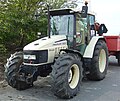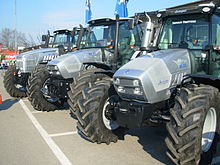Lamborghini Trattori
Lamborghini Trattori was founded in Pieve di Cento in 1948 by Ferruccio Lamborghini , the later founder of Lamborghini Automobili . In 1973 the company was integrated into the SAME group. The company logo was a triangle with the 3 letters "FLC" (Ferruccio Lamborghini Cento). Today Lamborghini is a brand of the SDF Group .
Company history
The founder of the company is the Italian mechanical engineer Ferruccio Lamborghini . After the end of the Second World War , Lamborghini first converted military vehicles left behind by the Allied forces into agricultural vehicles in a small workshop.
Using engines and differential gears from trucks and military vehicles obtained from the ARAR centers (Azienda recupero alienazione residuati, Italian government agency for redistribution of surplus materials), the first “Carioca” tractors were equipped with a major technical innovation. This is an evaporator that, when attached to a Morris engine, enabled the tractor to run on petrol and later to run on petroleum.
Within a few years the production could be increased from one tractor per week to approx. 200 per year and new engines of Italian design replaced the old relics of the war.
In 1951, the L 33, the first fully mass-produced tractor by Lamborghini, came onto the market. The only exception is the engine: a petroleum-powered, 3500 cm³ "Morris" 6-cylinder in-line engine with an evaporator patented by Ferruccio Lamborghini.
The Fanfani Act of July 25, 1952 - with which the state made 125 billion lire available at 3% interest for farmers who bought farm machinery from national production in 5 years - brought about another leap in the company's success. In the first five years of the 1950s, Lamborghini transformed from a workshop to an industrial company.
From 1952 the new models DL 15 , DL 20 , DL 25 and DL 30 came onto the market; and the following year the DL 40 and DL 50 models . In 1955, Lamborghini presented its first crawler tractor, the DL 25 C followed by the DL 30 C , which stood out for its yellow color.
In 1956 a new plant was opened. The following year, supported by the success of the Sametto from competitor Same, the Lamborghinetta (with a two-cylinder engine and 16 kW (22 hp), a weight of 1000 kg and a sales price of one million lire) came onto the market.
Starting in 1962, Lamborghini produced the “2R DT” model, a series of tractors with all-wheel drive and air-cooled engines. The success in tractors spurred Ferruccio Lamborghini to build sports cars. In 1963, Lamborghini built the first car.
At the end of the 1960s, Lamborghini tractors were the first in Italy to be equipped with synchromesh transmissions as standard and the range was enriched with high-performance models (R 480).
In 1973 Lamborghini sold the tractor division to competitor Same .
A new range of machines with new properties and water-cooled motors in modular design was created by 1983.
The end of the 1980s saw the introduction of the first electronic fuel injection and new control units for the tractor. In the new high-performance series "RACING" (1991) there was the "Electronic-Power-Shift-Transmission" for the first time.
Under the brand name Lamborghini, the "RUNNER", small tractors for small farms and the maintenance of green areas, came onto the market in 1993. In the following years, other new series were introduced under the brand name Lamborghini, such as the series: Racing, Champion, Premium, Agile and Sprint.
They were replaced by the R6, R7 and R8 series tractors at the beginning of the 21st century.
In 2013, the new Nitro tractor with a revised design and white painted body was presented at the SIMA international trade fair in Paris. Lamborghini Trattori has won a number of international awards with Nitro, including Tractor of the Year - Golden Tractor for the Design 2014 and the RedDot Award 2014.
Selection of models produced
Current products
Lamborghini tractors are built today in the SDF plants in Lauingen and Treviglio . At the beginning of 2016, the following tractor series were sold by Lamborghini:
- Mach VRT (210 to 250 hp)
- Spark (120 to 210 hp)
- Spark VRT (120 to 190 hp)
- Nitro (110 to 130 hp)
- Nitro VRT (110 to 130 hp)
- Nitro R (90 to 120 hp)
- Strike (80 to 115 hp)
- C SIX (110 hp)
- RS (80 to 110 hp)
- RV (80 to 110 hp)
- RF (80 to 110 hp)
- CF (90 to 100 hp)
- Spire (80 to 90 hp)
- CV (80 hp)
- R2 (70 to 100 hp)
- R2 Target (60 to 90 HP)
- Crono (65 to 80 hp)
- Record (65 to 75 hp)
- Ego (35 to 55 hp)
- Front loader
literature
- Hans-Karl Lange: Lamborghini. Verlagsunion Erich Pabel - Arthur Moewig KG, Rastatt 1991, ISBN 3-8118-3063-5 .
- Anthony Pritchard: Lamborghini. The history of the supercars from Sant'Agata. Heel Verlags GmbH, Königswinter 2006, ISBN 3-89880-574-3 .
Web links
Individual evidence
- ↑ Summary of the company's history on the website www.lamborghini-tractors.com .
- ↑ History on www.sdfgroup.com .
- ↑ Production sites on www.sdfgroup.com .
- ↑ Product range , on www.lamborghini-tractors.com ( Memento of July 2, 2015 in the Internet Archive ), accessed on February 15, 2016








